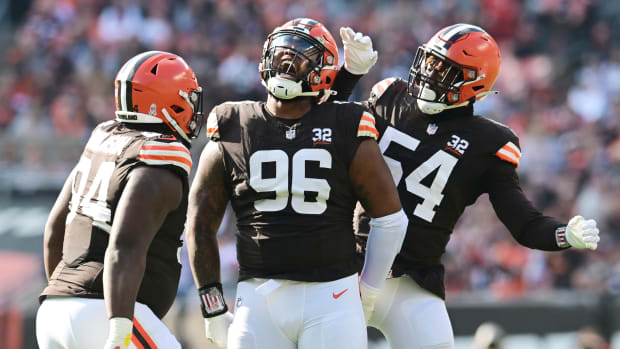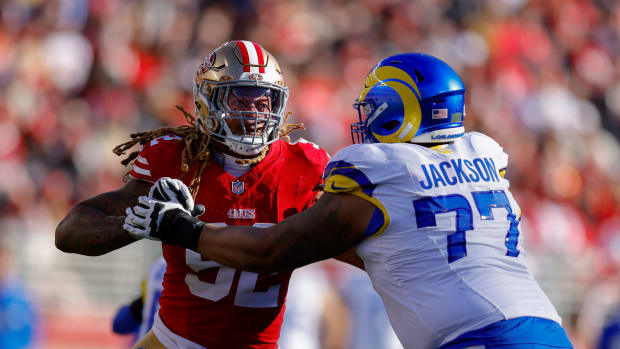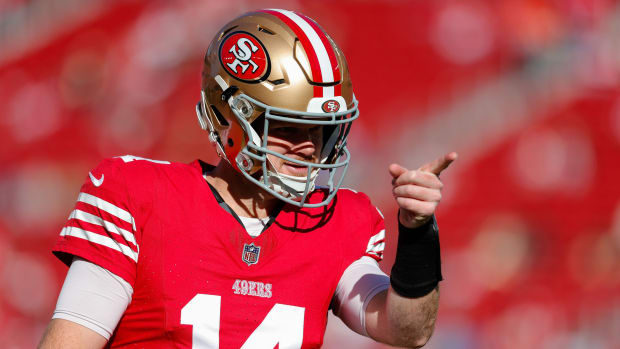How lineman Mike Daniels became the baddest man on the Packers' defense
This story originally appeared in the Sept. 12, 2016 issue of Sports Illustrated. Subscribe to the magazine here.
When the Packers traveled to Canton, Ohio, for the Hall of Fame Game against the Cowboys in early August, Mike Daniels got a chance to see inductee Orlando Pace, a seven-time Pro Bowl left tackle for the Rams who retired in 2009—all 6' 7" and 300-plus pounds of him.
“He was humongous!” says Daniels, seated in a dark leather chair deep inside Lambeau Field. “You don't really see any tackles that size anymore. I'm very glad for that.”
If there's a poster child for how much the NFL's trenches have changed since behemoths like Pace protected the edge, it's Daniels. The position that he plays—defensive end in a 3–4 Steelers-style, zone-blitz scheme—was stocked with massive, menacing men. In 2005, when Green Bay's current defensive coordinator, Dom Capers, was in his final season coaching the Texans, he started Robaire Smith (6' 4", 315 pounds) and Gary Walker (6' 3", 324 pounds) at that spot.
Despite rotating cast of QBs, the sky is the limit for WR DeAndre Hopkins
Now Daniels, a fourth-round pick out of Iowa in 2012, is the best player on Capers's Packers unit—and he's 6 feet and 291 pounds. “Historically, when you look at the 3–4 defense, yes, that body type doesn't fit,” says Green Bay coach Mike McCarthy. “But the fact of the matter is, it's a sub [or subpackage] league now, and he's perfect for that.”
Subpackage defenses are on the rise because with each passing year NFL offenses more closely mirror their college counterparts, spreading the defense horizontally by using multiple receivers detached from the line. That creates not only more space in the passing game but also more creases for the running game. Defenses combat this with extra DBs, speedier linebackers and smaller linemen, such as Daniels, who has thrived. In 2015 the Packers lined up in their base defense on just 18% of snaps. (The league average is 33%.) And that's not a one-year aberration. McCarthy can't recall the last time his team was over 20%.
“People talk about a defensive lineman being too short—but that's [less of an issue] today,” says Lions guard Larry Warford, who sees Daniels twice a season. “Shorter guys are hard to pass-block and run against; it's hard to get that leverage on them. Daniels is a game-changer.”
While Daniels represents the latest evolutionary step of the incredible shrinking defensive lineman, he's every bit as fierce as his predecessors. One play from Week 9 last season encapsulates all that he brings. Midway through the first quarter against the Panthers he lined up on the outside shoulder of left guard Amini Silatolu, facing an old-school, two-back alignment. On the snap Daniels backed up Silatolu a few steps by staying low and leveraging beneath Silatolu's pads. Then he used his brute strength, tossing the 6' 4", 320-pound Silatolu to the ground, and quickly flushed Cam Newton out of the pocket for an incomplete pass. “The difference between Mike and other short guys is that he's just absolutely strong,” says Warford. “He can throw you off balance easy and attack.”
“I've had quite a few plays where I've just dominated the guy across from me,” Daniels, 27, says matter-of-factly. “A lot of these defensive linemen, they're real whirling dervishes—they do all these fancy moves. I like to line up, punch a guy in his face, in his mouth, in his chest, then disengage, locate the ball, throw [my defender] and make a tackle. If you can do that consistently, you'll always have a job.”
Driven by his own expectations, Trai Turner has the Hall of Fame on his mind
Says Packers right guard T.J. Lang, who faces Daniels regularly in one-on-one pass-rush drills, “He plays low and with his hands really tight...It's hard to get control.” In late August, before he was cut by the Packers, left guard Josh Sitton added, “I would hate to have to block him over an entire game. He's relentless. He's a pain in the ass.” Sitton, who signed a three-year deal with the Bears on Monday, now has to face Daniels twice a year.
Daniels wasn't always so fearsome and willful. Small, skinny and admittedly nice to a fault, he was bullied in elementary school in Blackwood, N.J. Around the time he was seven, he came home crying. His father, Mike Sr., said it was time Mike learned to defend himself. And so he began a routine: 60 push-ups, 60 sit-ups and 60 squats every day. “I really wanted to be the biggest, baddest guy—not to mess with anybody, just so nobody would mess with me,” says Daniels.
In 2013, when Daniels was still a reserve, the Packers saw a stream of offensive players get knocked out of games with injuries. When tight end Ryan Taylor took an illegal hit to the head from linebacker DeAndre Levy during a 40–10 road loss to the Lions on Thanksgiving Day, Daniels finally snapped, telling a reporter that his teammates “need to get tougher, choke people, punch them in their throat.”
NFL Week 1 picks: The beginning of the road to Super Bowl LI
“Obviously I wasn't being serious,” he clarifies. “I was just saying, We need to be tougher. Look at the old Packers—those guys were mean. Reggie White would say, ‘Here comes Jesus,’ and then he'd club you into next week. But when I got here, to see us get pushed around by the Lions, I was like, When are we going to lay a bone-crushing hit? When are we going to send a message?”
Suffice it to say, the message has since been delivered by the subcompact, subpackage lineman whose stated desire is to “run through” an opponent, not around him. It's an attitude that has helped make Daniels the baddest man on one of the NFL's finest defenses.





































